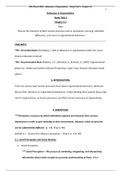©Du Plessis 2016 - Behaviour in Organizations – Study Task 2 – Chapter 3-5
1
Behaviour in Organizations
Study Task 2
Chapter 3-5
Topic:
“Discuss the relevance of basic human processes such as perception, learning, individual
differences, and stress in organisational behaviour.”
___________________________________________________________________________
TAKE NOTE:
*PB = Prescribed Book (Greenberg, J. (2011). Behaviour in organizations (10th ed.). Essex:
Pearson Education Limited)
*RB = Recommended Book (Robbins, S.P., Odendaal, A., & Roodt, G. (2004). Organisational
Behaviour: Global and Southern African Perspectives. Cape Town, Pearson Education South
Africa.)
1. INTRODUCTION:
There are various basic human processes that impact organisational behaviour. Below we
discuss their relevance on organisational behaviour. Understanding these aspects plays a big
role for organisations, as human processes can effect various outcomes of organisations.
2. PERCEPTION:
***Perception: a process by which individuals organise and interpret their sensory
impressions in order to give meaning to their environment. However, what we perceive
can be substantially different. (p. 119, Chap 6, RB)
(Exhibit 6.1 - Factors that influence perception – Chap 6, p. 119, RB)
2.1. Social Perception and Social Identity:
a. Social Perception:
*** Social Perception – The process of combining, integrating, and interpreting
information about others to gain an accurate understanding of them. When
, ©Du Plessis 2016 - Behaviour in Organizations – Study Task 2 – Chapter 3-5
2
forming opinions about people there is a powerful yet subtle process going on. This
process is when individuals judge and understand others with whom they come into
contact with. This process happens all the time and is automatic. Employees on all
levels can have profound effects on individuals. Understanding individual’s
employee’s work with may be very helpful, as it prevents any uncomfortable
scenarios with them.
***Attribution – Process through which individuals attempt to determine the
causes behind others’ behaviours – is used by individuals to determine behaviours
of others. It needs to be noted that it has its limits and errors.
(p. 103, Chap 3, PB)
b. Social Identity (Who am I?):
The other side of social perception is ***social identity – Who a person is, as
defined in terms of his or her membership in various social groups. This is how we
develop identities of ourselves with a social group. We also describe ourselves in
***Personal Identity – The characteristics that define a particular individual –
which are appearance, individual characteristics, personality, and special skills and
interest.
***Social Identity Theory recognizes that the way we perceive others and ourselves
is based on both our unique characteristics (i.e., personal identity) and our
membership in various groups (i.e., social identity). (Figure 3.1 – Chap 3, p. 104)
People love to associate themselves with groups who are seen as positive by society.
People with highly regarded professions are inclined to associate themselves with
their professions than other than those who have lower-status jobs. People think
positively of individuals who are members of a highly regarded groups (e.g. Doctor).
, ©Du Plessis 2016 - Behaviour in Organizations – Study Task 2 – Chapter 3-5
3
People also have a tendency to associate themselves with winning teams’ logos,
colours, etc. This is also known as ***basking in reflected glory – The tendency to
identify themselves with success of others such that those others’ success becomes
their own.
Top avoid making failure as part of their identities, people do what they can to
dissociate themselves with individuals or teams that have lost, this is known as
***cutting off reflected failure – the tendency for people to avoid making failure
part of their identities by dissociating themselves from individuals or teams that
have lost.
(p. 103-104, Chap 3, PB)
2.2. Attribution Process:
a. Making correspondent Inferences: Using Acts to Judge Dispositions:
Situations arise in organisations where we want to know what someone is like. We
tend to do this by observing others’ behaviours and the inferring their traits from
them. ***Correspondent inferences – judgements about people’s dispositions, their
traits and characteristics, that correspond to what we have observed of their
actions. (Figure 3.3, Chap 3, p. 106)
b. Casual Attribution of Responsibility:
Finding out why someone made a decision or taken action, will always be questioned
“why”? Two classes of explanations shows why we we do this:
i. ***Internal causes of behaviour – explanations based on actions for which the
individual is responsible. (e.g. the individuals in question’s behaviour)





